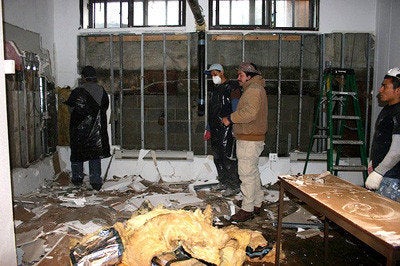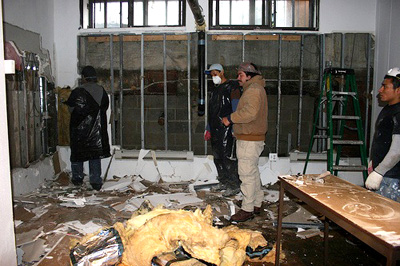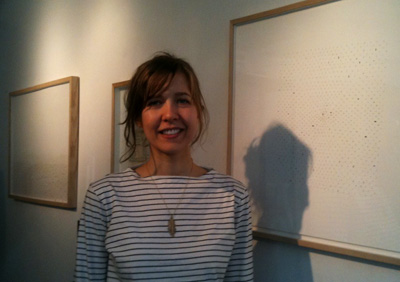
In the best of times, the life of an artist is difficult. Lean years, sacrifice and solitude are the norm. Add a natural disaster and life becomes even more precarious.
Such is the fate of seven artists in residence at the Smack Mellon gallery, whose building in Dumbo is separated from the East River by a sliver of Brooklyn Bridge Park. The location is inspiring, with views of Lower Manhattan and the Brooklyn and Manhattan bridges, but it also was in Hurricane Sandy's sights.
The artists were in the middle of their yearlong tenure at the gallery, set up in spacious basement work studios, when Sandy hit, flooding the building with six feet of salt- and sewage-laced water. Their sculpting tools and tubes of paint, not to mention painstakingly created works, were ruined, as was their precious space to create.

Workers remove walls in the damaged basement on Nov. 2, 2012 (Photo credit: Smack Mellon/Flickr)
"The artistic process just stopped," said Blane De St. Croix, a sculptor who was among the artists in residence. He estimates that he lost $58,000 in tools, supplies and art work in the flood.
But despite the financial setbacks and the loss of the studio, which suited his work in large-scale, environmentally-themed sculptures, De St. Croix is beginning to coax the creative process forward. The need to create is a powerful force that cannot be dampened for long, even by a disaster of the magnitude of Sandy.
"To live and work as an artist in New York City is a constant struggle," said Smack Mellon's executive director, Kathleen Gilrain. "To have something like this happen to them is to see how resilient they are."
The artists are continuing their residency program, which runs through the spring, in donated office space in a nearby building. Temporary walls have been erected to give each artist some defined space but it does not compare to the large, high-ceilinged studios with concrete floors and access to a kitchen, computer lab and wood shop that they had at the gallery.
The disaster, too, has became a shaping force in their work.
For De St. Croix, returning to work has meant spending more time at his computer researching his next project, an examination of environmental changes in the Arctic. After experiencing Sandy, he is resolved to find funding for an expedition to conduct an on-site survey, which he often does for a new work.
"It's reinforced the need for me to go to the Arctic. What happened in New York is in direct correlation to environmental change and global warming," De St. Croix said.
Throwing himself into the Arctic project has lessened the sting that lingers from having to destroy his last installation -- 12-feet-tall sculptures of wood, stucco, dirt and acrylic paint that celebrated the preservation of the Palisades cliffs. The sculptures were displayed at Wave Hill in the Bronx and the Hudson River Museum in Yonkers in a show that closed Dec. 2.
Preserving the works was not an option. With the financial hit he took with Sandy, De St. Croix said he could not afford new storage space and he no longer had a studio large enough to accommodate the works when the show closed. He does not know how the installation was destroyed. A curator at Wave Hill took care of it because De St. Croix said he would have found it too painful to be present. "I had nowhere to put them," he said.
Just as De St. Croix creates on a large scale, fellow artist-in-residence Skye Gilkerson works with the miniscule. Her biggest loss was a film canister filled with tiny paper cutouts that she and an intern had spent months collecting for her delicate collages.
"It just took the wind out of my sails," Gilkerson said. In addition to the work in progress, she lost archives of past creations, books and supplies.
But she, too, is back at work, her plants and drawing board newly installed in temporary studio space. Gilkerson said she was trying to "pick up where she left off," preferring to begin new work rather than restoring existing pieces damaged in the flooding. On recent weekday, a new intern was in her studio cutting out small pieces of text from magazines to replace the ones lost in the storm.

Artist Skye Gilkerson in the temporary studio space.
The only paper items she kept from the flooded studio were old sketchbooks, which she is storing in her freezer at home, a tip to avoid mold that she picked up at restoration workshop held at MoMA. She plans to take photos of each page to retain a record of her ideas.
Gilkerson said the hurricane was "devastating and painful and also kind of beautiful." It wiped out the to-do lists and backlog of work and forced her to live and work in the present moment, she said. "There is no other option."
While the artists return to work, Gilrain, the gallery's executive director, deals with the damage to the basement and worries about the future. Walking through the space, she pointed to the watermark left on the walls by the flooding and she moved a big industrial fan brought in to help dry out the rooms from the hallway to the kitchen.
Gilrain sees the artist-in-residence program as an important service to the city's artistic community. Artists, especially those at the beginning of their careers, find it increasingly difficult to live and work in New York, and securing studio space, through programs such as Smack Mellon's, can provide a boost to their careers.
And while she was encouraged by financial support the gallery has received since Sandy, she was unsure it would be enough to rebuild the downstairs studios and continue with the residency program.
"It's really, really important to keep artists in New York and to have good studio space for them to work with," she said in an earlier phone interview. "Working at their kitchen tables just isn't as conducive" to artistic growth, she said, "as having a thriving studio practice."
